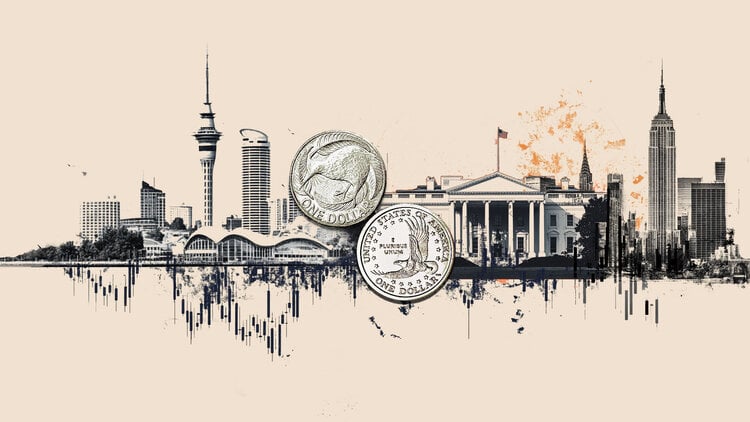- The New Zealand Dollar declines as the US Dollar experiences a rebound.
- The Greenback increases with upbeat Consumer Confidence, assisting gains.
- NZD/USD falls toward technical support, holding firm at the mid-point of the September to April decline.
The New Zealand Dollar (NZD) is losing ground against the US Dollar (USD) on Tuesday, slipping back after a failed attempt to break above the key 0.6000 level.
The pullback comes as concerns over US and EU trade tensions ease and the broader market mood becomes more stable, allowing the US Dollar to recover some of last week’s losses.
At the time of writing, the NZD/USD pair is trading near 0.5945 after encountering resistance at the psychologically significant 0.6000 mark and failing to build momentum beyond it.
With US markets back from the Memorial Day break, the USD is finding fresh support. A stronger-than-expected Consumer Confidence reading has helped fuel the rebound. The index rose sharply to 98 in May, up from 85.7 in April, reflecting a notable increase in optimism among US consumers.
The data highlights growing confidence in the economic outlook despite lingering global uncertainties.
That rejection has prompted a pullback toward the midpoint of the decline from September to April.
NZD/USD retreats with RBNZ rate decision, FOMC minutes ahead
For the Kiwi, Wednesday’s economic agenda remains a key focal point for investors as markets prepare for the Reserve Bank of New Zealand’s (RBNZ) interest rate decision, scheduled for 02:00 GMT.
Market participants are anticipating that the central bank will announce a 25 bps (0.25%) rate cut. The move would lower the benchmark rate to 3.25%, down from its current level of 3.50%.
Although the reduction has been priced into the NZD/USD exchange rate, the accompanying Monetary Policy Statement may help induce volatility.
With the report providing insight into the reasoning for the latest announcement and the projected economic outlook, any hawkish or dovish comments may result in a repricing of expectations for the trajectory of interest rates.
For the United States, the Federal Open Market Committee (FOMC) will release the Minutes of its May 6-7 meeting, when policymakers decided to keep the interest rate unchanged. The Minutes are expected to reveal clues on the Fed’s hawkish stance and could further help guide expectations for the timing of the next rate cut, currently priced in for September.
New Zealand Dollar FAQs
The New Zealand Dollar (NZD), also known as the Kiwi, is a well-known traded currency among investors. Its value is broadly determined by the health of the New Zealand economy and the country’s central bank policy. Still, there are some unique particularities that also can make NZD move. The performance of the Chinese economy tends to move the Kiwi because China is New Zealand’s biggest trading partner. Bad news for the Chinese economy likely means less New Zealand exports to the country, hitting the economy and thus its currency. Another factor moving NZD is dairy prices as the dairy industry is New Zealand’s main export. High dairy prices boost export income, contributing positively to the economy and thus to the NZD.
The Reserve Bank of New Zealand (RBNZ) aims to achieve and maintain an inflation rate between 1% and 3% over the medium term, with a focus to keep it near the 2% mid-point. To this end, the bank sets an appropriate level of interest rates. When inflation is too high, the RBNZ will increase interest rates to cool the economy, but the move will also make bond yields higher, increasing investors’ appeal to invest in the country and thus boosting NZD. On the contrary, lower interest rates tend to weaken NZD. The so-called rate differential, or how rates in New Zealand are or are expected to be compared to the ones set by the US Federal Reserve, can also play a key role in moving the NZD/USD pair.
Macroeconomic data releases in New Zealand are key to assess the state of the economy and can impact the New Zealand Dollar’s (NZD) valuation. A strong economy, based on high economic growth, low unemployment and high confidence is good for NZD. High economic growth attracts foreign investment and may encourage the Reserve Bank of New Zealand to increase interest rates, if this economic strength comes together with elevated inflation. Conversely, if economic data is weak, NZD is likely to depreciate.
The New Zealand Dollar (NZD) tends to strengthen during risk-on periods, or when investors perceive that broader market risks are low and are optimistic about growth. This tends to lead to a more favorable outlook for commodities and so-called ‘commodity currencies’ such as the Kiwi. Conversely, NZD tends to weaken at times of market turbulence or economic uncertainty as investors tend to sell higher-risk assets and flee to the more-stable safe havens.

